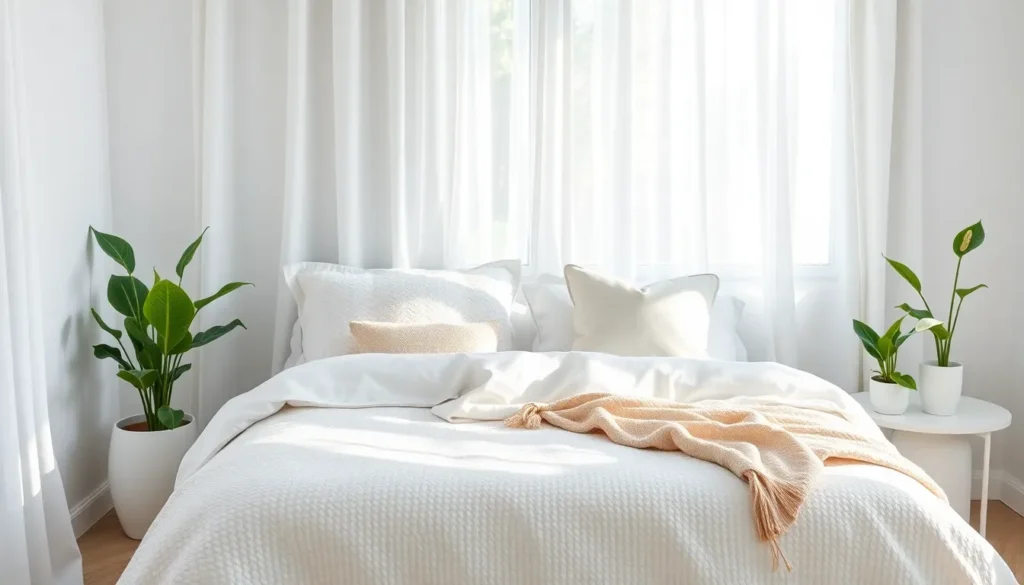White bedrooms offer the perfect canvas for creating a serene sanctuary that promotes rest and relaxation. When we combine the crisp cleanliness of white decor with the natural beauty of plants we unlock a design formula that’s both timeless and incredibly effective. This color palette doesn’t just look stunning – it actively enhances our sleep quality and overall well-being.
The magic happens when we introduce carefully chosen plants into our white bedroom spaces. These green companions don’t just add visual interest and texture – they’re working around the clock to purify our air and create a healthier sleep environment. From trailing pothos cascading from floating shelves to elegant snake plants standing guard in corners we have countless options to transform our bedroom into a botanical retreat.
We’re about to explore how this winning combination can revolutionize your personal space turning your bedroom into the peaceful oasis you’ve always dreamed of having.
Choose the Right Plants for Your White Bedroom Sanctuary
Selecting appropriate plants transforms your white bedroom sanctuary into a living space that promotes both aesthetic appeal and wellness. We’ll explore three essential categories that ensure your plant choices complement your serene white bedroom environment.
Low-Light Tolerant Options
Snake plants thrive in bedroom conditions with minimal natural light requirements. These architectural beauties feature upright green leaves with yellow edges that create striking vertical lines against white walls. We recommend placing snake plants in corners or beside dressers where they’ll receive indirect light throughout the day.
ZZ plants adapt exceptionally well to bedroom environments with low lighting conditions. Their glossy dark green leaves reflect available light while requiring watering only once every two to three weeks. These resilient plants work perfectly on nightstands or bedroom floors where direct sunlight rarely reaches.
Pothos vines cascade beautifully from hanging planters or tall furniture pieces. We’ve found these trailing plants particularly effective when positioned on top of wardrobes or mounted wall shelves. Their heart shaped leaves in variegated green and white patterns complement white bedroom color schemes perfectly.
Chinese evergreens display stunning foliage patterns that add visual interest without overwhelming white decor. These compact plants feature leaves with silver, pink, or red markings that serve as natural artwork. We suggest grouping different Chinese evergreen varieties on plant stands for layered visual appeal.
Air-Purifying Varieties
Peace lilies eliminate common indoor air pollutants while producing elegant white blooms. NASA research confirms these plants remove formaldehyde, benzene, and trichloroethylene from bedroom air. We place peace lilies near windows where they receive bright indirect light and bloom regularly.
Spider plants generate oxygen during nighttime hours while filtering harmful chemicals. These prolific plants produce small white flowers followed by baby plantlets that dangle from the mother plant. We recommend hanging spider plants near bedroom entrances where their cascading babies create natural green curtains.
Rubber trees absorb important amounts of carbon dioxide while releasing fresh oxygen. Their large glossy leaves collect dust particles from bedroom air while requiring minimal maintenance. We position rubber trees in bedroom corners where their substantial size creates natural focal points.
Aloe vera plants purify air while providing natural healing properties for minor skin irritations. These succulent plants store water in their thick leaves and prefer bedroom windowsills with morning sunlight exposure. We keep aloe vera plants accessible for their practical healing benefits alongside their air cleaning capabilities.
Pet-Safe Plant Selections
Boston ferns offer lush greenery without posing toxicity risks to cats or dogs. These feathery plants prefer humid conditions and indirect light making them ideal for bedroom environments. We mist Boston ferns regularly and place them on plant stands away from curious pets.
Prayer plants feature distinctive leaf patterns that fold upward during evening hours. These non-toxic beauties display green leaves with dark spots and red undersides that complement white bedroom themes. We position prayer plants on bedside tables where their evening leaf movement creates natural entertainment.
Parlor palms bring tropical elegance to white bedrooms while remaining completely safe for pets. These slow growing palms reach maximum heights of four feet making them perfect floor plants for bedroom corners. We water parlor palms when soil feels dry and appreciate their air purifying qualities.
Peperomia varieties offer diverse leaf shapes and textures in compact pet-friendly packages. These small plants feature thick succulent-like leaves in various colors from deep green to silver striped patterns. We cluster different peperomia types on dressers or floating shelves for interesting textural displays.
Create Visual Balance with Strategic Plant Placement
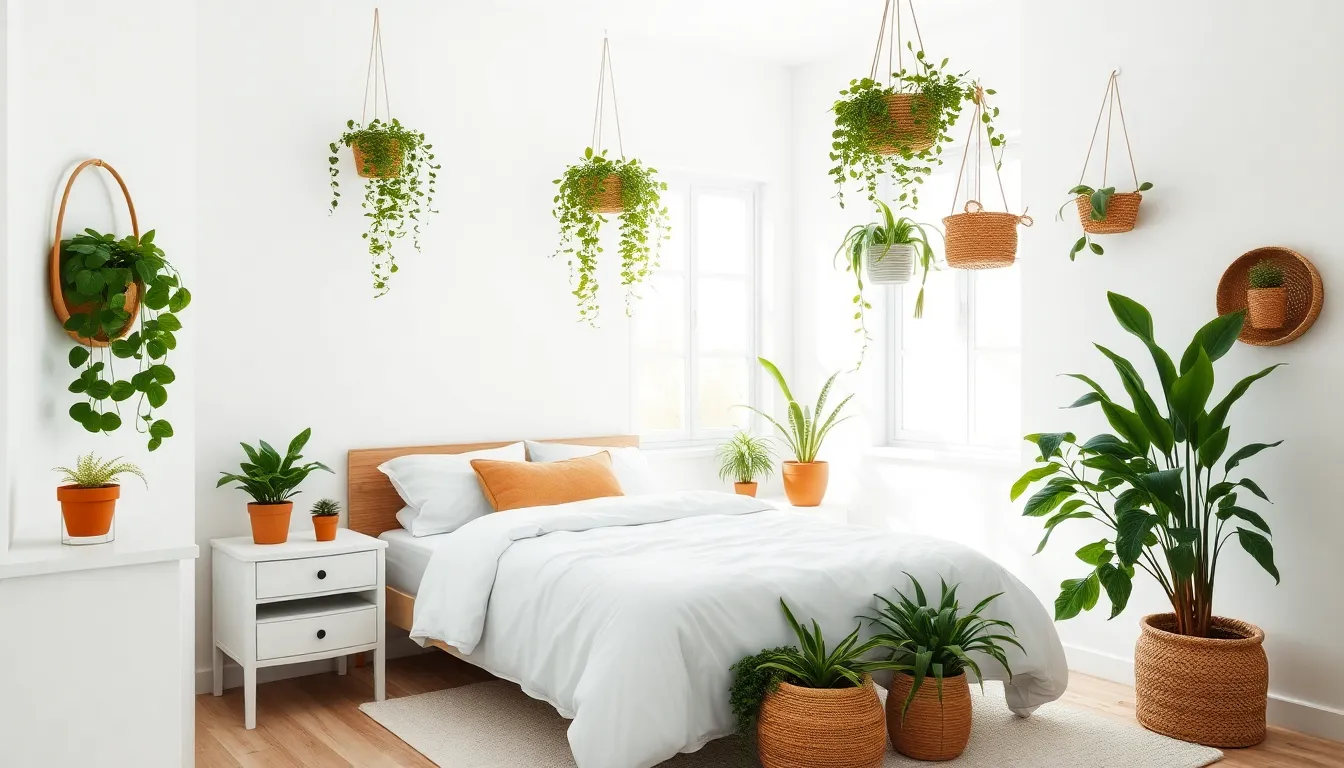
Now that we’ve selected our ideal plants, we need to position them strategically to create harmony in our white bedroom sanctuary. Visual balance comes from layering plants at different heights and locations throughout the space.
Bedside Table Arrangements
Small tabletop plants on bedside tables transform the minimalist white aesthetic into something warmer and more inviting. We recommend stacking planters on side tables to give featured plants a “pedestal” effect that draws the eye upward. Terracotta pots and woven baskets serve as excellent container choices that add natural warmth and personality to stark white surfaces.
Pothos, snake plants, and small succulents work perfectly in these compact spaces since they require minimal maintenance. These plants soften hard edges of furniture while maintaining the clean lines that make white bedrooms so appealing. Space constraints make these varieties ideal because they won’t overwhelm nightstands or dressers.
Floor Plant Positioning
Floor plants should occupy spots near windows or bright corners to maximize natural light exposure. Tall varieties like monstera, fiddle leaf figs, and snake plants create dramatic height without cluttering our carefully curated space. We avoid oversized statement plants in limited spaces, instead choosing medium sized varieties to maintain an airy, balanced atmosphere.
Strategic positioning opposite bedside table plants or other furniture creates harmonious flow throughout the room. Varying plant heights between floor and table displays adds texture and depth that prevents the white backdrop from feeling flat or sterile. This layered approach ensures our bedroom feels lived in rather than showroom perfect.
Hanging Plant Displays
Hanging plants maximize our greenery without sacrificing precious floor or surface space. Devil’s Ivy (Pothos) excels in hanging displays because it trails down beautifully while thriving in bright indirect light with minimal watering requirements. These cascading plants add organic softness that contrasts perfectly with crisp white walls and linens.
We position hanging plants near high surfaces such as freestanding wardrobes or window areas where foliage can cascade naturally. This placement allows trailing vines to create gentle curves and movement that bring life to otherwise static white rooms. The vertical element these displays provide helps draw attention upward, making ceilings appear higher and spaces feel more expansive.
Select Complementary White Decor Elements
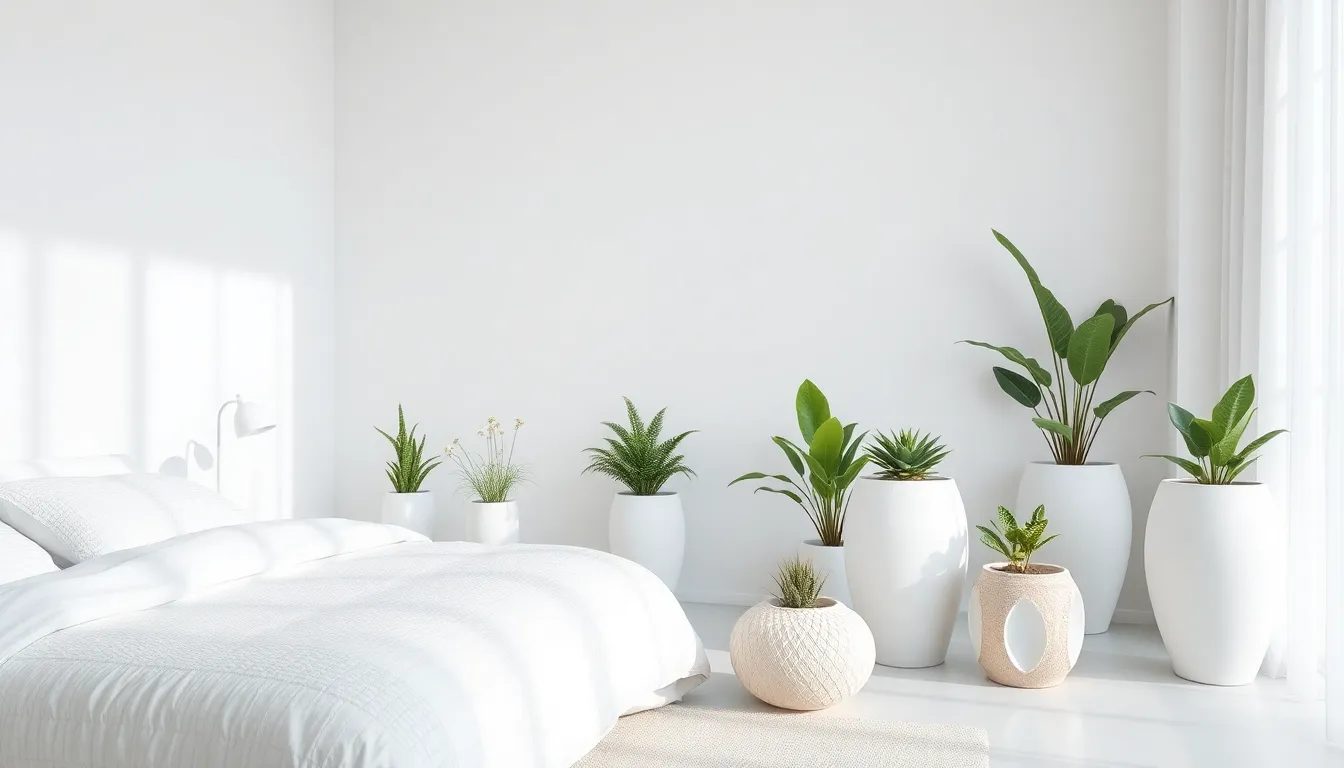
Now that we’ve strategically placed our plants, let’s focus on the white decor elements that’ll create a cohesive foundation for our bedroom sanctuary. We’ll enhance the serene atmosphere by carefully selecting complementary pieces that add depth and visual interest without overwhelming the space.
Textured White Bedding Options
Layering different textures prevents our all-white bedroom from feeling flat or sterile. We recommend starting with a quilted duvet cover as your base layer, then adding chunky knit throws draped across the foot of the bed for tactile appeal. Embroidered pillows in subtle white-on-white patterns introduce visual interest while maintaining the monochromatic scheme.
Mixing linen sheets with cotton percale creates depth through varied textures and sheens. We suggest incorporating a faux fur throw pillow or cable knit blanket to add cozy elements that invite touch. These layered textiles create a sanctuary-like atmosphere similar to luxury spa environments, making your bedroom feel more welcoming and lived-in.
Minimalist White Furniture Pieces
Streamlined furniture with clean lines maintains the airy, uncluttered vibe we’re creating. We choose simple white nightstands without ornate details to keep our plants as the main focal points. Platform beds or those with sleek headboards work best because they don’t compete with the natural beauty of our greenery.
Floating shelves provide display space for smaller plants while keeping the floor area open and spacious. We avoid furniture with excessive curves or decorative elements that might clash with the minimalist aesthetic. Simple white dressers with flat surfaces offer additional opportunities to showcase our carefully chosen plants without creating visual chaos.
White Ceramic and Stone Planters
White ceramic planters create seamless integration between our decor and plant life while highlighting the vibrant green foliage. We select planters with subtle texture variations like ribbed surfaces or matte finishes to add visual interest without disrupting the cohesive color scheme. Natural stone planters in light colors like limestone or marble bring organic elements that complement both the white palette and living plants.
Hanging white macrame planters work particularly well for trailing plants like Devil’s Ivy, adding vertical dimension near windows or from ceiling hooks. We choose planters in varying heights and shapes to create visual rhythm throughout the space. Simple cylindrical or geometric planters maintain the clean aesthetic while providing proper drainage for healthy plant growth.
Incorporate Natural Light Sources Effectively
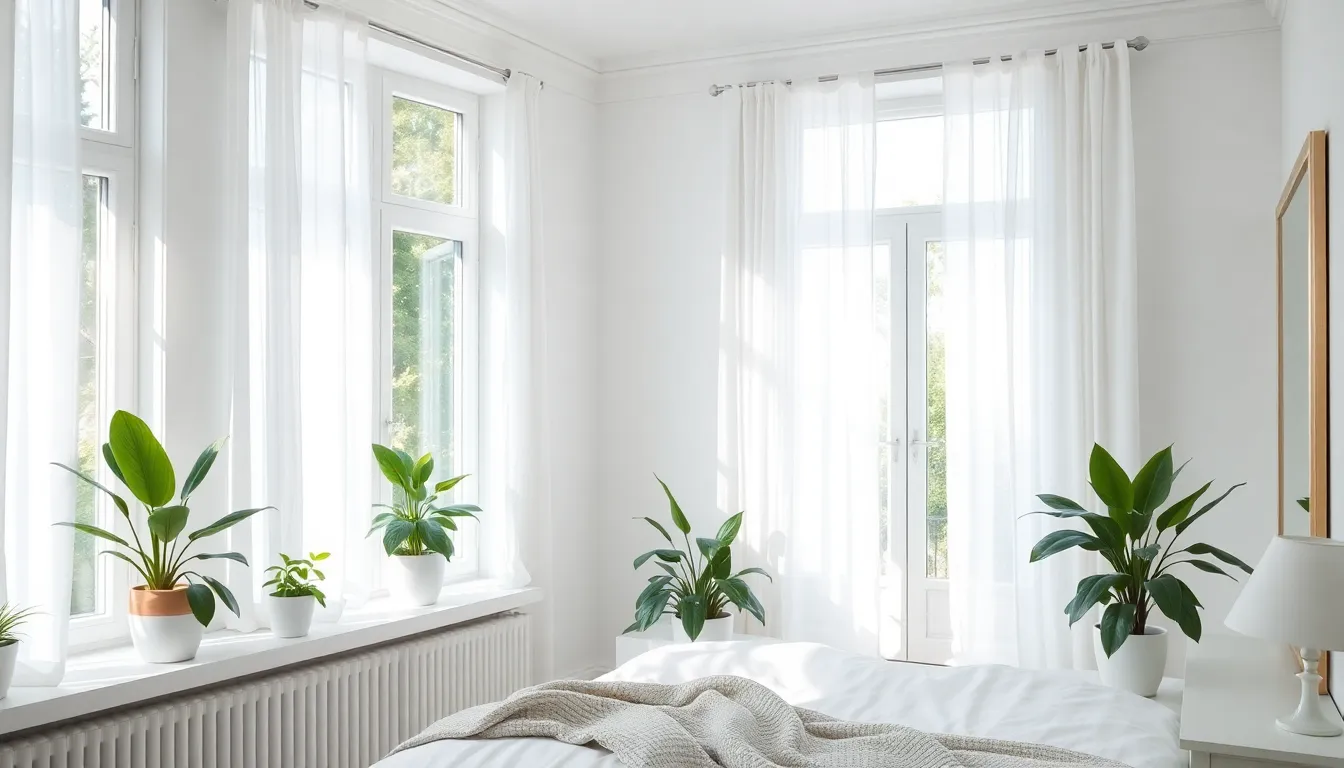
Natural light serves as the foundation for both healthy plant growth and the crisp, calming atmosphere we want in our white bedroom sanctuary. We can position plants near windowsills or in areas where they receive ample indirect sunlight to maximize their growth potential.
Window Treatment Answers
Sheer white curtains maximize light penetration while adding softness and continuity to our white bedroom theme. We recommend using these lightweight fabrics because they enable sunlight to illuminate the room and nurture plants without overwhelming them with heat. Light filtering blinds or shades offer another excellent option that we can adjust according to the season and time of day. These adjustable treatments ensure our plants like Devil’s Ivy, snake plants, and jade get optimal light exposure since they thrive with bright but not direct sunlight.
Mirror Placement for Light Reflection
Mirrors enhance natural light by reflecting it deeper into our bedroom, effectively brightening dark corners that are perfect for moderate light plants. We should place mirrors opposite or adjacent to windows to bounce light across the room, supporting plant health while amplifying the airy, spacious feel of our white bedroom. This strategic placement technique also visually enlarges the space, making our room feel more open and fresh. Reflected light reaches areas where we might want to position plants that don’t require direct sunlight exposure.
Supplemental Grow Light Options
LED grow lights that mimic natural sunlight become essential in bedrooms with limited natural light exposure. We can use these energy efficient options to supplement light for tropical plants like Monstera or Agave that prefer more consistent lighting conditions. Compact grow lights blend well with white decor and can be discreetly positioned near plant groupings on shelves or bedside tables. These supplemental lighting answers ensure our plants receive adequate light year round, maintaining their health and vibrant appearance regardless of seasonal changes or room orientation.
Design Cohesive Color Schemes with Green Accents
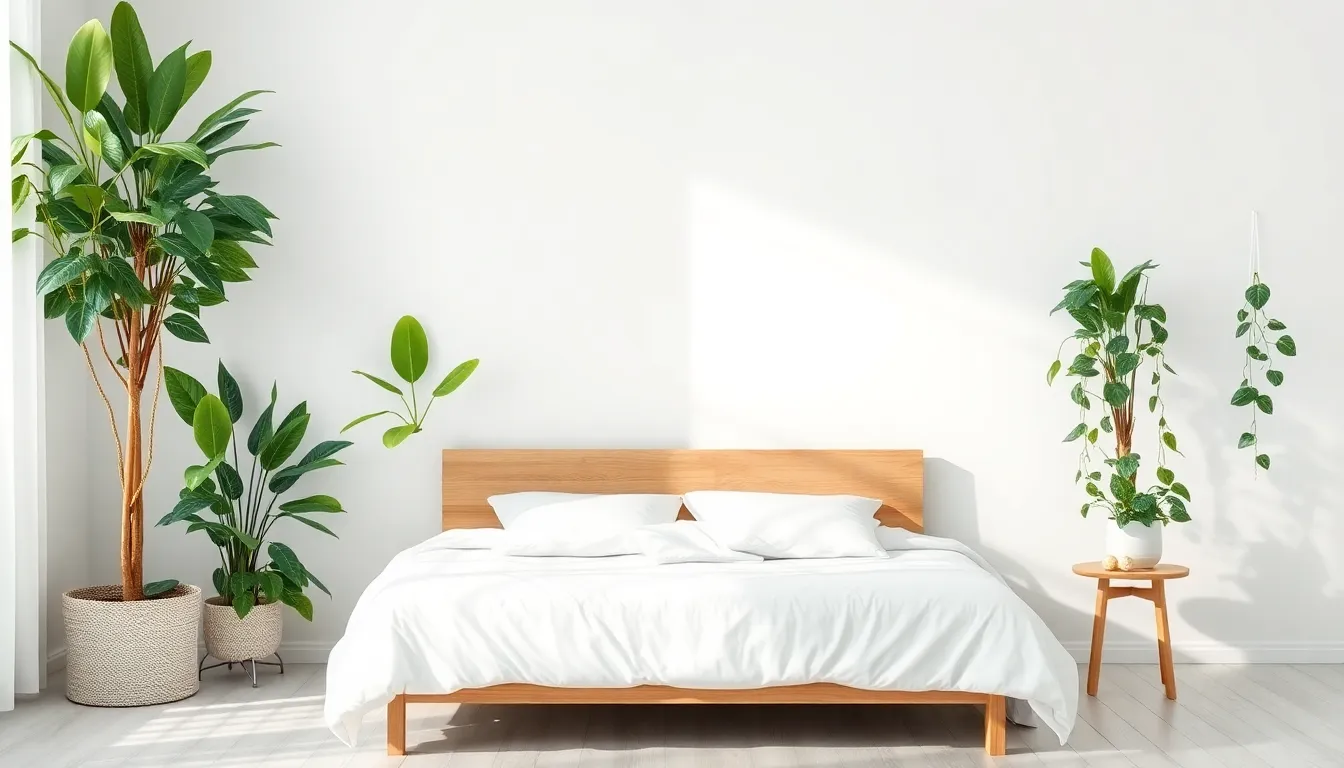
We’ll create a harmonious color foundation that lets your plants shine as natural focal points while maintaining the serene atmosphere you’ve established.
Monochromatic White Base Palette
Using white walls, bedding, and furniture creates a clean neutral backdrop that transforms your plants into vibrant focal points. We recommend establishing this minimalist base because it prevents overwhelming the space while allowing green accents to add just the right amount of visual interest. White furniture pieces with clean lines maintain that airy atmosphere we’ve been building throughout your bedroom sanctuary.
Layering different white textures prevents your monochromatic scheme from feeling flat or sterile. We suggest combining matte white walls with glossy white ceramics, soft cotton bedding, and smooth painted furniture surfaces. This textural variety adds depth while keeping your color palette cohesive and calming.
Subtle Green Tone Variations
Incorporating plants with different shades of green creates visual depth that complements your white foundation perfectly. We recommend mixing deep emerald varieties like rubber trees with lighter lime hued plants such as pothos vines to establish natural contrast. These varying green tones prevent your bedroom from feeling monotonous while maintaining that fresh, organic aesthetic.
Choosing plants based on their foliage color helps you create intentional groupings throughout the space. We suggest positioning darker green plants like snake plants near your white furniture to create striking contrast, while lighter green varieties work beautifully against white walls. This strategic color placement ensures your plant selection feels purposeful rather than random.
Natural Wood Accent Integration
Natural wood elements balance the coolness of white and green while adding warmth to your bedroom sanctuary. We recommend introducing wooden bed frames, floating shelves, or plant stands to create organic connections between your decor and plant life. These wood accents enhance the natural theme while providing practical surfaces for displaying your green collection.
Selecting wood tones that complement your plant selection creates a more cohesive design story. We suggest choosing lighter oak or pine finishes that won’t compete with your white base palette, allowing the natural grain to add subtle texture. Wooden plant stands and bedside tables serve dual purposes by supporting your plants while contributing to that organic, lived in atmosphere you’re creating.
Maintain Plant Health in Bedroom Environments
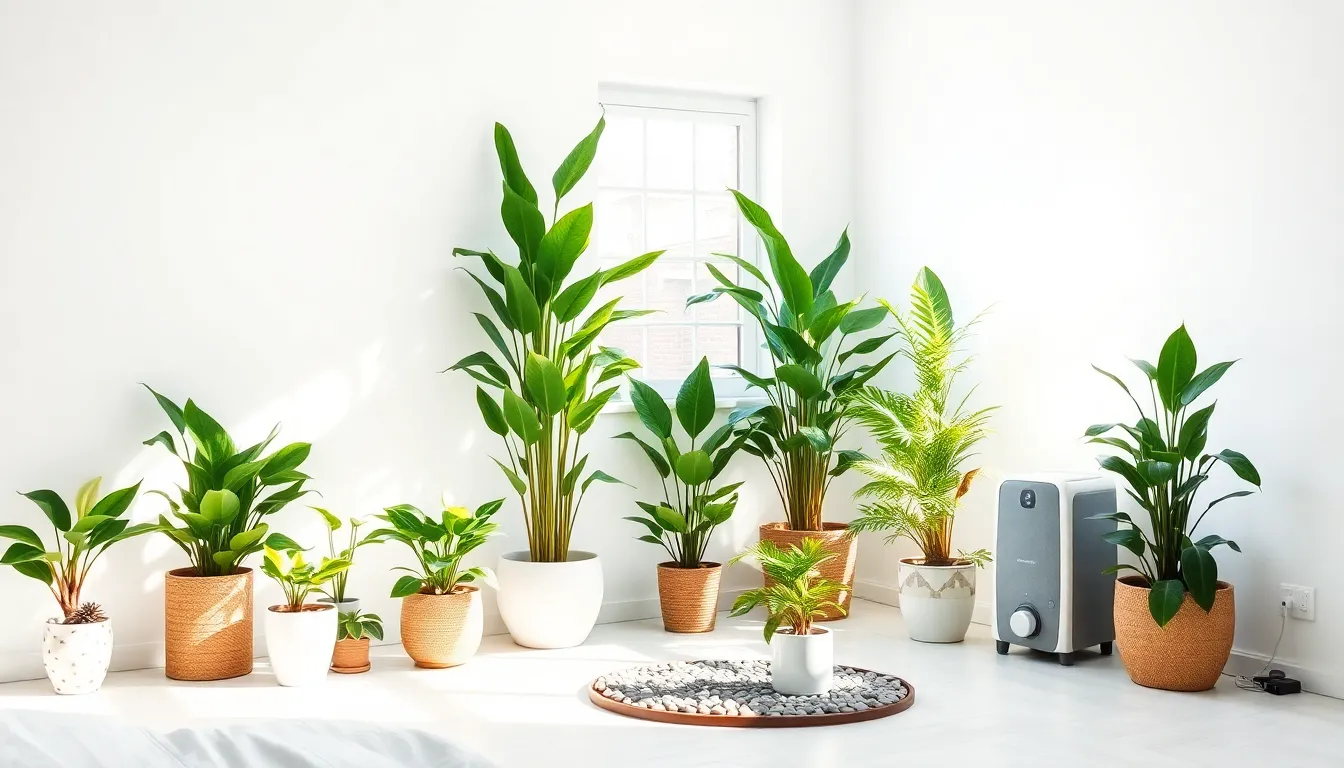
Keeping our green companions thriving in a white bedroom requires understanding their exact needs and creating optimal growing conditions. We’ll ensure our plants remain vibrant and healthy by focusing on three essential care elements.
Proper Watering Schedules
Watering schedules should align with each plant’s exact moisture requirements rather than following a rigid calendar. We check the soil moisture by inserting our finger about an inch deep into the potting mix, watering only when it feels slightly dry but not completely parched.
Overwatering poses the greatest threat to indoor plant health as it causes root rot and fungal issues. We prevent waterlogging by using well-draining pots with drainage holes and selecting potting mixes designed for indoor plants. Different species have varying water needs; snake plants and ZZ plants prefer their soil to dry out completely between waterings, while Boston ferns and peace lilies thrive with consistently moist soil.
Seasonal adjustments help maintain optimal watering routines throughout the year. We reduce watering frequency during winter months when plant growth slows and increase it during spring and summer active growing periods.
Humidity Level Management
Humidity levels significantly impact plant health, especially for tropical varieties that naturally grow in moisture-rich environments. We create humid microclimates around our plants by placing pebble trays filled with water beneath their containers, allowing evaporation to increase surrounding moisture levels.
Grouping plants together helps establish beneficial humidity zones where they support each other’s moisture needs. We position our tropical plants like prayer plants and Boston ferns in clusters to maximize this natural humidity sharing effect.
Small bedroom-friendly humidifiers provide consistent moisture control without overwhelming the space. We maintain humidity levels between 40-60% for most houseplants, which also creates comfortable sleeping conditions for us. Regular misting isn’t recommended as it can promote fungal growth on leaves and soil surfaces.
Temperature Considerations
Temperature stability plays a crucial role in maintaining healthy bedroom plants throughout the year. We keep our bedroom temperatures between 60°F and 75°F (15°C to 24°C), which supports both optimal plant growth and comfortable sleep conditions.
Avoiding temperature fluctuations helps prevent plant stress and maintains consistent growth patterns. We position plants away from heating vents, air conditioning units, and drafty windows that can create sudden temperature changes. Most houseplants struggle with temperatures below 50°F (10°C) or above 85°F (29°C).
Nighttime temperature drops of 5-10 degrees actually benefit many plants by mimicking their natural environments. We ensure adequate air circulation by keeping bedroom doors open during the day or using a small fan to prevent stagnant air conditions that can harbor pests and diseases.
Style Different White Bedroom Layouts
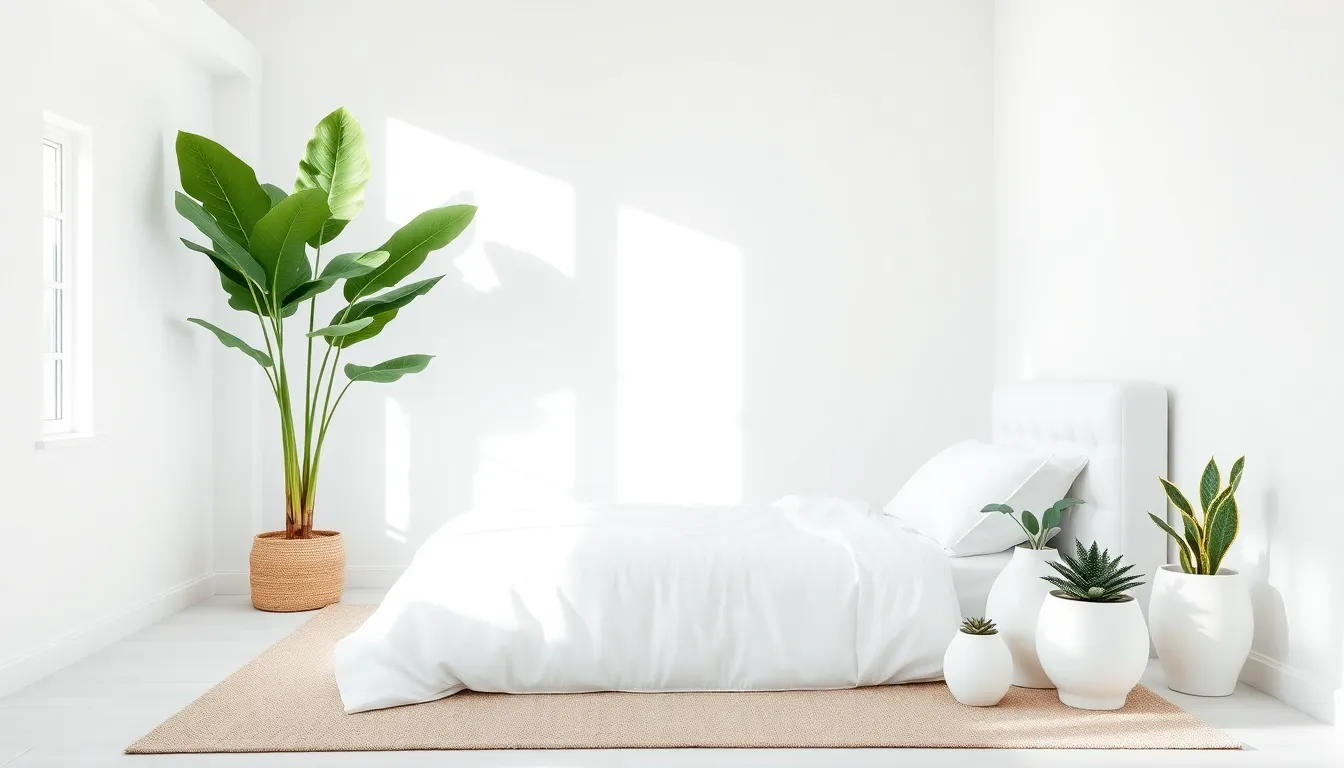
White bedrooms offer incredible versatility, adapting seamlessly to different room sizes and design preferences. We can transform any space into a serene sanctuary by choosing the right approach for our exact layout needs.
Small Space Answers
Small bedrooms benefit tremendously from white walls and furniture that create an illusion of spaciousness and openness. We recommend positioning white beds against the longest wall to maximize floor space while keeping the room bright and airy. Integrated storage answers like white wardrobes with built-in shelving help maintain an uncluttered appearance without sacrificing functionality.
Plants work exceptionally well in compact spaces when we choose strategically. Large statement plants like fiddle leaf figs placed in bright corners draw the eye upward, making the room feel taller. Small succulent arrangements scattered on floating shelves or nightstands bring fresh color without overwhelming the limited square footage. Hanging planters with trailing pothos or spider plants add vertical interest while preserving precious floor space for movement.
White shiplap walls paired with woven baskets create texture and dimension that prevents the room from feeling sterile. We can layer different white textiles like quilted throws and linen pillows to add warmth while maintaining the bright, open atmosphere that makes small spaces feel larger.
Master Bedroom Designs
Master bedrooms allow us to embrace white as a tranquil foundation for more elaborate design elements. We can layer soft white textiles across the space, incorporating tufted headboards, linen bedding, and neutral area rugs with subtle patterns for added personality. Symmetrical arrangements work particularly well in larger spaces, with matching lamps or mirrors flanking the bed to create visual balance.
Strategic plant placement becomes crucial in master bedrooms where we have more room to work with. Large plants positioned near windows maximize natural light exposure while creating natural focal points throughout the space. We can group plants of varying heights like monstera, rubber trees, and peace lilies to establish different zones within the bedroom while maintaining the cohesive white backdrop.
Statement rugs with gentle patterns help define the sleeping area without disrupting the serene white palette. Natural wood elements like bed frames or plant stands add warmth and organic texture that balances the coolness of white surfaces. We can incorporate white ceramic planters in different sizes to create visual rhythm while keeping the plant containers cohesive with the overall design scheme.
Minimalist Bedroom Approaches
Minimalist white bedrooms emphasize clean lines, simplicity, and intentional design choices that promote calm. We focus on tonal variations of white and soft off-white shades to create depth without visual clutter. Every element serves a purpose, from the streamlined white bed frame to carefully chosen bedside essentials.
Plants become essential focal points in minimalist spaces where decoration is deliberately sparse. Single large plants like fiddle leaf figs or snake plants make powerful statements without competing for attention. We can select white or neutral planters that blend seamlessly with the minimal aesthetic while allowing the plant’s natural beauty to shine.
Clean geometric shapes dominate the furniture selection, with white pieces featuring straight edges and unadorned surfaces. Storage remains hidden or integrated to maintain the uncluttered appearance that’s central to minimalist design. We layer textures through bedding and minimal accessories rather than decorative objects, ensuring the space feels warm and inviting even though its simplicity.
The beauty of minimalist white bedrooms lies in their timeless quality and ease of customization. We can introduce seasonal plant varieties or swap out single decorative elements without disrupting the core design, making these spaces both serene and adaptable to changing preferences.
Choose Appropriate Plant Containers and Stands

Selecting the right containers and stands transforms our white bedroom plant display from ordinary to extraordinary. The perfect vessel becomes an extension of our design vision while supporting healthy plant growth.
White Ceramic Pot Options
White ceramic pots create seamless integration within our monochromatic bedroom palette, allowing plant foliage to become the star attraction. These versatile containers come in various finishes from glossy to matte, helping us maintain visual cohesion without introducing color distractions. Small succulents like Agave thrive beautifully in white ceramic vessels, creating low-maintenance accents that perfectly complement our bright, airy space.
Ceramic containers offer excellent drainage capabilities when paired with proper saucers, preventing root rot while protecting our white furniture and floors. Different textures within white ceramics add subtle visual interest through varying light reflections across glossy and matte surfaces. We can mix sizes strategically, using smaller pots for bedside tables and medium containers for floor arrangements near windows.
Natural Woven Basket Styles
Woven baskets introduce organic texture that creates beautiful contrast against our crisp white walls and linens. These natural containers add warmth and dimension without overwhelming our room’s minimalist foundation, serving as both functional plant holders and decorative elements. Plants like Devil’s Ivy or English Ivy placed in woven baskets deliver that perfect boho-natural vibe when positioned on shelves or floor areas.
Basket weaving patterns create visual movement that breaks up stark white surfaces while maintaining our peaceful atmosphere. We can use different basket heights to create layered displays, elevating some plants while keeping others at floor level for ever-changing arrangements. Natural fibers in these containers complement wooden bed frames and plant stands, strengthening our connection to organic elements throughout the space.
Modern Plant Stand Designs
Modern plant stands elevate our greenery into prominent focal points while adding architectural interest to our white bedroom. Clean-lined designs in materials like black metal, gold accents, or natural wood tones create striking contrast against white backgrounds, drawing the eye upward and outward. Freestanding plant displays featuring trailing varieties like Devil’s Ivy or statement plants like Monstera highlight our greenery elegantly within minimalist or Scandinavian décor styles.
Metal stands offer durability and sleek aesthetics, while wooden options bring warmth that balances the coolness of our white and green color scheme. We can choose different heights to create visual rhythm, using tall stands for corner placements and shorter ones for beside furniture arrangements. Multi-tiered stands maximize our plant display potential in smaller spaces, allowing us to showcase several varieties without sacrificing precious floor area.
Conclusion
We’ve shown you how to transform your bedroom into a peaceful white sanctuary that promotes better sleep and wellbeing. The combination of white decor with carefully selected plants creates a space that’s both visually stunning and functionally beneficial for your health.
Remember that success lies in choosing the right plants for your exact conditions and maintaining them properly. Whether you’re working with a small space or a large master bedroom the principles remain the same: strategic placement thoughtful container selection and attention to lighting will make all the difference.
Your white bedroom with plants doesn’t have to be complicated to be effective. Start with one or two easy-care plants and gradually build your collection as you gain confidence. The result will be a serene retreat that helps you unwind and recharge every single day.
Frequently Asked Questions
What are the best plants for a white bedroom sanctuary?
The best plants for white bedrooms include low-light tolerant options like snake plants, ZZ plants, and pothos vines. Air-purifying varieties such as peace lilies, spider plants, rubber trees, and aloe vera improve indoor air quality. For pet owners, safe choices include Boston ferns, prayer plants, parlor palms, and peperomia varieties.
How should I arrange plants in my white bedroom?
Place small tabletop plants on bedside tables using terracotta pots or woven baskets. Position floor plants near windows for optimal light, choosing medium-sized varieties like monstera or fiddle leaf figs. Add hanging plants like Devil’s Ivy for vertical interest without sacrificing floor space, creating a layered, inviting atmosphere.
What white decor elements work best with bedroom plants?
Layer different white textures like quilted duvet covers, chunky knit throws, and embroidered pillows to prevent flatness. Choose minimalist white furniture with clean lines, white ceramic or stone planters for seamless integration, and hanging macrame planters for trailing plants to add vertical dimension and proper drainage.
How do I maximize natural light for bedroom plants?
Position plants near windowsills or areas with indirect sunlight. Use sheer white curtains and light-filtering blinds to maximize light penetration. Place mirrors strategically to reflect natural light into dark corners. For limited natural light spaces, supplement with LED grow lights to support tropical plants year-round.
What color scheme works best for a plant-filled white bedroom?
Use a monochromatic white base with walls, bedding, and furniture to let plants serve as vibrant focal points. Layer different white textures like matte walls with glossy ceramics. Incorporate plants with varying green shades and add natural wood elements like bed frames and plant stands for warmth and balance.
How do I maintain plant health in my bedroom?
Check soil moisture regularly and adjust watering frequency seasonally, avoiding overwatering. Maintain humidity for tropical plants using pebble trays and grouping plants together. Keep temperatures between 60°F-75°F and avoid drafts. Understanding each plant’s specific needs ensures they thrive in your bedroom environment.
What containers work best for white bedroom plants?
White ceramic pots offer seamless integration and excellent drainage with varying finishes for visual interest. Natural woven baskets add organic texture and warmth. Modern plant stands elevate plants and provide architectural interest. Choose containers that transform plant displays into extraordinary design elements while maintaining the monochromatic aesthetic.

